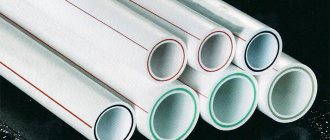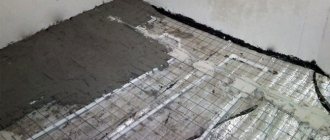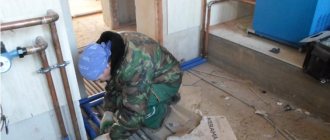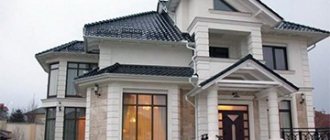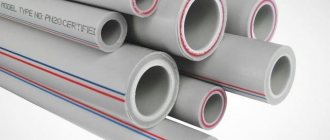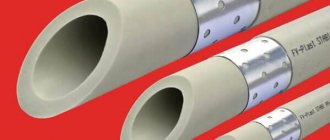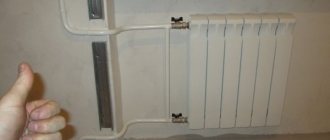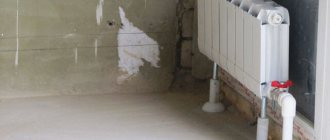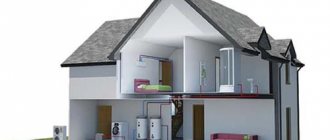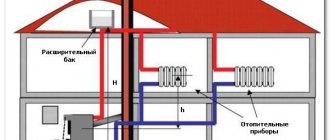When choosing a heating pipe, pay attention to the marking - it contains the maximum permissible pressure and temperature readings.
What criteria should you use to make a choice?
In order to make the right choice of pipes for installing a heating system, we need to have a good understanding of their markings and relevant parameters. One of the main indicators is working pressure. It is customary to indicate it in the pipe marking directly after the letter combination PN. For example, PN20 means that this pipe is intended for use at an operating pressure of 20 atmospheres and a temperature of 20 degrees. In this case, we do not mean peak pressure indicators, which can be several times higher than those indicated, but maximum long-term operating pressure indicators.
Fittings used for installation of polypropylene pipes.
If we talk about how to choose polypropylene pipes for heating, then it would be preferable to use PN25 pipes for these purposes. Indeed, with an increase in the maximum temperature of the coolant, the tensile strength of polypropylene pipes decreases significantly. This circumstance leads to the fact that at 900ºС the limit of tolerable pressure for a product marked PN20 is no longer 20, but approximately 6.5 kg/cm². This is acceptable, but less desirable, since a sudden increase in pressure in the heating system can lead to an accident.
Fitting: structural elements for plastic pipes (read more)
Temperature indicators must be clearly marked on the pipe or in the form of an indication of the possibility of use in heating systems (hot&cold). As mentioned earlier, heating pipes must be reinforced. It doesn’t matter how it’s made: fiberglass or foil.
Long sections of polypropylene piping must be supplemented with expansion joints or pipe turns.
When choosing polypropylene pipes, you must not miss the issue of purchasing tools for installing heating from them. Perhaps the main link here is the soldering iron.
How to choose a soldering iron for polypropylene pipes
The assembly of any pipeline using polypropylene is carried out by welding. All pipe sections of the required length are connected into a system of the required configuration using special fittings. They are selected according to the size of the selected pipes.
On a note! You must buy connectors and pipes from the same company. In this case, there will be no problems with joining the parts, and the melting temperature will be identical. After all, both overheating and underheating of various elements negatively affects the connection, which threatens a rupture in this place of the system.
The structure of a soldering iron for polypropylene pipes.
For a tight and airtight connection with the fittings, the pipes and these parts are heated to the melting point of polypropylene. This is done with special soldering irons. Sometimes they are also called irons or welding machines. It’s worth talking separately about how to choose a soldering iron for polypropylene pipes.
Fittings for polypropylene pipes and other types of polymer products (read more)
Requirements of state standards and labeling
Any PP pipe, in addition to type marking and reinforcement, must have certain limits on the maximum withstand production pressure. This parameter has the abbreviation PN and limits ranging from 10 to 25 units. The diameter is indicated along the outer boundaries. Moreover, the higher the pressure indicator, the thicker the pipe wall will be. For a better idea, the following examples can be given:
- Diameter 16-20 millimeters - water supply installation in a private house or apartment;
- Diameter 25-32 millimeters - pipes for the riser;
- Diameter more than 32 millimeters - pipeline systems on main networks, sewers and multi-apartment buildings.
The manufacturer sometimes applies a red or blue stripe to the surface of the product, which is not a technical characteristic, but only serves as a way of signaling the purpose of the pipe. Everything here is intuitive: blue color means the pipe carries cold water supply, and red color means it is laid in the heating circuit and carries hot coolant in the DHW system.
In addition to colored stripes, the tubes may contain markings of letters, which will indicate the technical characteristics for installation in the required heating systems and water supply systems. As an example, we can mention that the alphanumeric marking PN-20 is suitable for a heating system, but a pipe marked PN-25 would be preferable, because it will have a pronounced resistance to high temperatures, as well as to pressure, and even with significant in stock.
What types of soldering irons are there?
Such welding machines can be supplied separately or in a set with the necessary nozzles, scissors for cutting pipes, gloves, a building level and a tape measure. All this is placed in convenient suitcases made of plastic or metal. Such sets are supplied in metal or plastic suitcases.
Tool for cutting polypropylene pipes.
An important characteristic of irons for welding polypropylene is their power. Here you don’t need to chase heavy-duty expensive devices, since you simply won’t need them if you are designing indoor heating where there are no pipes with a diameter of more than 50 mm. For household purposes, it will be enough to purchase a soldering iron with a power of 600 to 800 W. You can guide your purchase by the attachments included with the device. Their diameter corresponds to the pipes that the device can solder.
When choosing a soldering iron, important attention should be paid to the thermostat. The quality of the resulting weld depends on the accuracy of its calibration and the ability to “maintain” an even temperature. This circumstance is especially important for beginners, since experienced craftsmen do not need prompts from the device; they are guided by their feelings and intuition. Anyone who is just learning to solder should adhere to all standards. For this reason, it is better to purchase a soldering iron with continuously variable temperature control.
Nozzles of various diameters for soldering iron.
If you are a beginner and you are concerned about the question of how to choose polypropylene pipes for heating, then you should purchase branded, time-tested products with accompanying documents. They have all the characteristics of pipes, and most importantly, the melting point. This information will help you correctly set the temperature regulator on the soldering iron, depending on the diameter of the pipes and fittings, which will make the seam high-quality and completely safe for use.
What are the advantages of polypropylene (PP) batteries?
Polypropylene pipes are used quite widely. And this is due to the presence of a number of significant advantages of this type of structure. Among the main positive aspects are the high thermal conductivity coefficient. This allows heat loss to be kept to a minimum. Such products have welded connections. And this is much more reliable and durable when compared with collet connections. And it allows you to significantly extend the service life of the product. It should also be noted that the price of PP heating pipes is low. Almost anyone can install a polypropylene pipeline.
Polypropylene structures can be conventional or reinforced. Ordinary ones are susceptible to the negative effects of high temperatures: when heated, the size of the product may change. Therefore, when equipping heating with natural circulation from polypropylene, it is better to choose a reinforced option.
Polypropylene pipes in the water heating scheme of a private house
Pipe distribution transfers the flow of thermal energy from the boiler to the heating devices. Water is the traditional coolant for heating systems for country houses. The amorphous nature of the polymer to an aggressive environment under the influence of high temperatures is the key to the durability of pipes. The inner surface of the pipes offers negligible resistance to the directional movement of flow. Impurities contained in the coolant in suspension (organics, compounds of hardness salts, scale, sand particles) do not form deposits on the walls of polypropylene pipes. Aluminum-reinforced products prevent oxygen from entering the heating system from the pipeline. A layer of foil metal reduces the risk of corrosion of the boiler heat exchanger and increases the service life of the system as a whole. Numerous materials, diagrams, and videos of do-it-yourself heating in a private home can be easily found on the Internet.
Polypropylene pipes in the heating system of a private house.
Emergency freezing of pipe lines does not threaten the destruction of polypropylene pipes. After defrosting the water, the material restores its original properties. However, it should be remembered that it is impossible to heat PP pipes using open fire!
The increase in the linear dimensions of the pipe when heated is perhaps the only significant drawback of polypropylene products. Reinforcement with aluminum foil significantly reduces the rate of thermal expansion and increases the quality of pipes.
Note! In country houses, antifreeze is not used for heating systems made of propylene (the permitted pipe material for anti-freeze coolant is steel, copper, brass and plastic, with a rubber outer contour).
Heating scheme: 1 - polypropylene pipes; 2 - ball valve; 3 — direct-flow radiator valve; 4 - expansion tank; 5 - circulation pump; 6 - check valve; 7 - security group; 8 - radiator; 9 - thermostatic valve; 10 - radiator valve; 11 - plug; 12 — Mayevsky crane; 13 — ball valve; 14 - plug; 15 - thermostatic head.
Considering that the optimal pressure in the circuit of a household boiler is 1.5÷2 bar, the heat source is as close as possible to the consumer and the temperature in a residential building does not fall below 5°C, we conclude: aluminum-reinforced polypropylene is an ideal material for piping in a private home.
Which PPR pipes are suitable for heating
Polypropylene pipes began to be used for heating systems relatively recently. Before this, their place was taken by solid steel pipes. Such structures were connected by welding, were durable, but difficult to install and expensive to manufacture.
Polypropylene pipes have gone through a number of important metamorphoses over their short history. Polypropylene itself does not have the heat resistance that the companies developing it expected. That is why the first heat-conducting systems with such pipes quickly fell into disrepair, and they began to be skeptical about the material itself.
At the moment, polypropylene pipes have been significantly improved. There are various models that are used to supply cold and hot water, heat supply and sewage disposal. When carrying out repairs, it is important to choose pipes that are designed for specific purposes, otherwise the structure will not be suitable for use.
It is important! At the moment, there are many companies producing and selling pipes for heating systems. It is advisable to buy pipes along with all components from official suppliers in specialized stores, since there are many low-quality fakes.
Types of PPR pipes
Polypropylene pipes are used in various areas, but not all are suitable for heating. In pursuit of cheap material, you may buy the wrong type of pipe that could withstand hot water under pressure. It is important to be able to distinguish one type of pipe from another.
The classification of polypropylene pipes is as follows:
- RR-N. This is the first generation of polypropylene pipes. This model has all the properties of the base material. PP-N are hermetically sealed and resistant to high pressure, in addition, they do not enter into chemical reactions. However, melting of such a pipe can begin already at a temperature of 50 ͒ C. Such pipes are used in cold water supply systems, ventilation and for industrial purposes;
- RR-V. During the production of this type, the formula of the material was slightly changed. The pipes turned out to be stronger and more durable, but they still could not withstand temperature fluctuations. Such pipes have the advantages of previous generation and, in addition, better withstand the effects of hot temperatures. However, they are unsuitable for heating systems and even hot water supply. Such pipes are often used in sewer construction;
- PP-R. In the production of these pipes, in addition to polypropylene, ethylene is used. This allows them to withstand high temperature loads. In addition, such pipes, as a rule, are reinforced, which allows them to withstand temperatures of more than 100 ͒ C. Reinforced PP-R pipes are the most suitable option for a heating system.
We recommend that you read: How to select and install a compensator for greater reliability of systems made of polypropylene pipes
Reinforced pipes
Reinforcement is the process of covering a pipe with a material that, in terms of strength or other properties, is superior to the main material of the structure. In the case of polypropylene pipes, reinforcement means coating the pipe with metal, which retains heat and prevents pipe deformation under the influence of high temperatures. Reinforcement can be of two types:
- Aluminum. In this case, the surface of the pipe is covered with aluminum foil. Sometimes such foil is embedded between layers of polypropylene. Aluminum does not allow PPR to expand and change its shape. However, such pipes have one significant drawback - they can delaminate. Delamination occurs if the pipe is made of low-quality materials or is improperly joined to another pipe;
- Fiberglass. This coating is woven between layers of polypropylene. This makes the delamination process impossible. Such pipes are integral and do not deteriorate due to improper installation or operation. The service life of PPR with fiberglass coating is longer, however, such pipes are more expensive.
Technical characteristics of heating pipes
The characteristics of pipes are based on resistance to various factors that act during operation. When choosing pipes for a heating system, you need to pay attention to the following parameters:
- High pressure resistance. Reinforced polypropylene pipes can withstand a system pressure of 6 atm. at a temperature of 70 ͒C. The higher the temperature, the less resistance to pressure. In the heating system, hot water is not supplied at maximum pressure;
- Temperature resistance. Polypropylene pipes with reinforcement begin to melt at a temperature of 120 ͒ C. In the heating network, the temperature rarely exceeds 70 - 75 ͒ C, which creates a reserve of heat capacity in the system. PPR can withstand frost worse than heat;
- Non-corrosive. The main disadvantage of metal pipes is the possibility of reacting with water. Sooner or later, such pipes rust and cease to be airtight. Polypropylene does not corrode when exposed to water. Moreover, it does not react with salts and other impurities that may be found in the system;
- Durability. Manufacturers promise a pipe service life of half a century, but do not give guarantees. In fact, the durability of the structure depends on the type of reinforcement, the correct installation, the temperature inside and outside the pipes, and the pressure in them. If you follow all the recommendations, you can forget about repairs for several decades.
It is important! Polypropylene pipes can be installed outdoors only for residents of the southern regions. When the temperature outside the system is less than -15 ͒ C, polypropylene becomes brittle and pipes may break. Such designs are only suitable for pipelines located indoors.
Selection of heating pipes
For heat pipes, it is better to give preference to polypropylene with fiberglass reinforcement. However, pipes made of this material are also different. They vary in diameter and ability to withstand a certain pressure in the system. The following categories of pipes are distinguished by diameter:
- Less than 1.6 cm. Such pipes are suitable exclusively for underfloor heating systems. This diameter should be sufficient if the pipes are installed correctly;
- 2.0 - 2.5 cm. The most popular diameter when installing heating in a house or apartment. For the riser that goes into the apartment, a diameter of 25 mm is required, and pipes of 20 mm are installed in the rooms;
- 2.5 - 3.2 cm. This category is used in multi-storey buildings with centralized heating;
- More than 20 cm. Pipes of this diameter are needed for large organizations. For example, hospitals with many departments, wards and offices.
We recommend that you read: PVC pipes for swimming pool equipment
It is not difficult to determine the pressure that the pipes can withstand. Just look at the PN marking and the number after it. Thus, PN 10 can withstand a pressure of 10 atmospheres at a temperature of 45 ͒ C, PN 16 - 16 atm. at a temperature of 60 ͒ C, PN 20 - pressure 20 atm. at a temperature of 80 ͒ C, PN 25 - 25 atm. at a temperature of 100 or more ͒C. For the heating system, you must choose at least PN 16, preferably PN 25.
Thus, the best option for heating pipes is fiberglass-coated polypropylene pipes with a diameter of 2 - 2.5 cm and marked PN 25.
Rules for contact heat welding of polypropylene
Installation of heating systems made of polypropylene is carried out at a room temperature of at least 5°C. Consumables for heat sealing (accessories) must be suitable for the intended purpose (PPRS).
Steps for connecting polypropylene pipes using a soldering iron.
Sequence of operations in the manufacture of components at the work site:
- the pipe is cut using special scissors according to preliminary markings on the body;
- preparation of the cut surface includes chamfering to a depth of 1 mm at an angle of 30° and degreasing the end of the pipe with acetone;
- marking the boundaries of the melt - a restrictive mark is applied to the end of the pipe with a pencil;
- processing of soldering iron working surfaces;
- heating the instrument;
- melting of parts (with time ranges of pipe diameters according to the device passport, and the alignment of parts with the iron body);
- joining of a unit without displacement or rotation of elements;
- cooling.
Size of embedded pipe section for heating:
| Diameter, mm | 20 | 25 | 32 | 40 | 50 |
| Distance from the end, mm | 14,5 | 16 | 18 | 20,5 | 23,5 |
Stages of work on connecting polypropylene pipes.
Time regulations for the manual thermal welding process (normative values):
| Pipe outer diameter/fitting inner diameter, mm | Time, s | ||
| Contact with nozzle | Docking | Cooling | |
| 20 | 5 | 4 | 120 |
| 25 | 7 | 4 | 120 |
| 32 | 8 | 6 | 240 |
| 40 | 12 | 8 | 300 |
The electric voltage in the soldering iron for polypropylene is 36V. Operation of the tool from a household network requires the presence of a circuit breaker.
After the joints have cooled, check the straightness of the joint, the uniformity of the weld bead and the absence of welding defects. The number of connecting nodes, when following the rules of contact welding, does not affect the throughput of the system. Low resistance in welded parts is due to the physical properties of the material and the method of connection without reducing the flow area of the pipe. Hydraulic tests for the strength and density of the PP pipe system are carried out 16 hours after welding.
Connecting pipes using special glue (cold welding).
DIY heating installation
You can install the heating system yourself. The main thing is to choose the right materials, compare them correctly and seal them tightly. The design itself is quite simple to assemble and operate.
What connectors to use
In order to attach one pipe to another, pipes to risers and radiators, pressure gauges and other devices, special connectors are needed. The following types are distinguished:
- Straight (regular couplings). They are necessary in those places where one pipe connects to another of the same diameter, but not at an angle;
- Curved. Used in places where the system bends and rotates;
- Triples. They are needed if you need to make two from one pipe or one from two. For example, in the places where branches extend from the main pipe to the radiator;
- Blind (stubs). They are installed in “dead-end” areas, for example, on the outer radiators;
- With a change in the internal section. They are used when moving from a larger diameter pipe to a smaller diameter pipe. For example, when connecting pipes with risers;
- With plastic and metal. Such connectors are necessary in places where there is a transition from plastic products (pipes) to metal ones (radiators, pressure gauges, tanks).
Before starting installation work, it is necessary to recreate on paper the exact diagram of the proposed system and calculate the number of connectors of each type. In addition, it is important to select connectors whose internal diameters will coincide with the diameters of the pipes.
We recommend that you read: Types of pneumatic fittings and criteria for selecting elements for pneumatic systems
Installation work algorithm
After drawing up a heating scheme and purchasing all the necessary elements, you can begin installation work.
To do this, you will need a special kit consisting of a soldering iron with attachments (couplings and drones) and shaders.
It is not necessary to purchase it to install one heating system; it can be rented.
It is important! When carrying out work for the first time, it is recommended to buy more parts than necessary. After improper welding, the disconnected parts are no longer suitable for use, so you will have to take new ones.
The installation algorithm looks like this:
- Cutting pipes and laying out connectors. This is a preparatory stage that is important to perform strictly according to the instructions. The pipe is cut using special scissors.
- Cleaning pipes with a shaver. This step is only necessary when installing pipes with aluminum reinforcement. To do this, take a shaver and put it on the pipe, and rotate it manually or with a screwdriver.
- Soldering iron assembly. Couplings and mandrels of the appropriate diameter are put on the apparatus, after which it is turned on and heated to 260 ͒ C. At this time, a depth mark is made on the pipe corresponding to the connecting element.
- Compound. A pipe is inserted into the coupling of a heated soldering iron to a certain depth, and a connecting element is inserted into the mandrel on the other side, after which the elements are soldered to each other over a certain period of time. The time is calculated as follows: with a pipe diameter of 1.6 cm - 5 seconds, 2.0 cm - 7 seconds, 3.2 cm - 8 seconds.
- All other sections of the pipe are assembled in a similar way, after which the structure is connected to the heating system.
Features of installation in an apartment and private house
It is easier to install a heating system in an apartment. As a rule, one radiator is installed in each room, which extends from a common riser. The pipes are connected according to the proposed scheme, and then connected to the riser and radiator.
If you install several radiators, you can choose two-pipe and single-pipe heating systems. In the first case, the coolant flows from each previous radiator to the next one. Accordingly, in all subsequent radiators the temperature will be lower than in the previous ones. In the second case, there are two pipes: one for liquid input, the other for output.
Before carrying out work in the apartment, it is necessary to coordinate heating repairs with the housing office and the closest neighbors. Replacement of risers is usually carried out centrally.
When installing a heating system in a private house, there will be more work . It is necessary to select the type of coolant, the type of boiler and the system for removing the coolant from the boiler and in the reverse order.
Installing the boiler itself can also cause difficulties if you lack experience. The heating pipe is usually installed in the basement of the house. The boiler is then connected by pipes to radiators in each room. Such systems are quite complex, but they also have advantages - the temperature and pressure in the pipes can be adjusted independently.
Water heating schemes made of polypropylene for a private house
A non-volatile or pressure, one- or two-pipe scheme is chosen based on considerations of efficiency and comfort. Traditionally, private houses are equipped with horizontal wiring with independent floor contours. The heating system for small houses with natural circulation is a chain of radiators connected in series. Effective heat supply to a large house is carried out using a two-pipe system with forced movement of the coolant.
High-quality installation and piping of equipment is impossible without calculating the throughput and determining the diameter of the pipes at each section. The coincidence of calculated and actual costs will reduce heat losses and ensure stable, reliable and silent operation of the system.
Installation of polypropylene pipes with an L-shaped thermal expansion compensator.
Using an online calculator, you can make a hydraulic calculation for a single-pipe water heating circuit for a private house with your own hands. The DanfossCO and OvertopCO programs perform calculations for indoor heating systems with natural circulation. Calculations in Excel Online are summarized in a convenient tabular form. By filling out the source data column and selecting the necessary constants (the columns are highlighted in color), we obtain the calculation results.
The classic method of arranging a heating system is single-pipe wiring. A thematic video of heating a private house made of propylene can explain the installation. You can quickly, accurately and cheaply strap the equipment with your own hands.
Piping diagram for a heating system with a U-shaped compensator.
Systems with single-pipe distribution and natural circulation operate under the influence of gravity. The slope when laying pipes and installing the heat generator below the level of living quarters will increase the flow rate. However, when connecting radiators in series, it is impossible to distribute heat evenly. Rooms remote from the boiler are poorly heated, and there is a danger of stopping circulation and boiling of boiler water.
The problem is solved by heating a private house with your own hands in the “Leningradka” scheme. Videos can be found on the Internet.
The removal of pipes to heating devices divides the flow; most of the coolant continues to flow through the system. The flow through the radiator is regulated by installing a thermostat valve, diagonally connecting the device, or changing the bypass flow area.
An example of arranging a loop-shaped compensator when installing PP pipes.
What else to look for when choosing polypropylene pipes for heating
Above we looked at different types of polypropylene pipes that can be used for heating installation, their advantages and disadvantages. Based on this information, we can conclude that if price is not a decisive factor for you, then it is better to choose reinforced varieties. Moreover, it is better to choose products reinforced with foil if they are made by a well-known, trusted manufacturer. Otherwise, it is better to opt for polypropylene pipes reinforced with a layer of fiberglass. Moreover, there are fewer problems with them when soldering.
In addition to choosing a type, there are also criteria such as:
- operating pressure;
- maximum operating temperature;
- diameter;
- manufacturer.
Pressure
The operating pressure must be indicated on the label. As a rule, this is the number after the letters PN (PN20, PN25) and it indicates what maximum long-term operating pressure (in atmospheres or bar) the pipe can withstand at a coolant temperature of 20˚C. It must be remembered that as the temperature of the coolant increases, this indicator decreases. So, for example, for a pipe with the designation PN20 at a temperature of 90˚C it is no more than 6.5 atm (bar, kgf/cm2). Although for most heating systems this is quite enough. For example, in autonomous systems, it rarely exceeds 1.5 atm.
Temperature
The maximum operating temperature must also be indicated on the pipe markings. Since they will be used for heating, its value should be at least 90˚C. Most manufacturers usually indicate the maximum temperature value in numbers. But the designation “hot&cold” may also occur, which means that the pipes can be used for hot water.
Diameter
The minimum diameter of polypropylene pipes for heating is 20-26 mm, and the maximum is 32-40 mm and depends on the type of boiler, type of circulation, length of lines and other factors. In order to know what diameter and how many pipes to buy, you must first calculate the heating system. For different systems, the diameters of the pipes and their number will be different. It is best if such a calculation is made by an experienced specialist. It should be remembered that when calculating, we obtain the minimum internal diameter, and on the marking of polypropylene pipes, as a rule, the outer diameter is indicated.
Manufacturer
Currently, quite a few manufacturers, both domestic and foreign, are engaged in the production of polypropylene pipes. The more reliable the manufacturer, the higher the price of its products. Although you can find decent options among inexpensive products.
Let us give an example of manufacturers whose product quality has been tested by time.
Among the European brands one can name German Rehau, Banninger, Akwatherm, Wefatherm and Czech FV-Plast, Ekoplastik. Their products are high quality, but they are also the most expensive on the market.
If the prices of these manufacturers are not suitable for you, you can pay attention to the products of Turkish manufacturers such as Vesbo, Firat, TEBO, Pilsa, Kalde and Jakko. Their products are cheaper and the quality is decent.
Pipes from Chinese manufacturers Blue Ocean and Dizayn have proven themselves to be of good quality at a low price.
Domestic ones include Polytek, RVK, PRO AQUA, Heisskraft or Santrade.
Do-it-yourself heating in a private house from polypropylene pipes
The main components of heating are a heat generator, pipes and heating devices. The rest of the equipment ensures the system operates under various loads. Equipping the system with additional elements depends on the size of the house and the modification of the selected boiler. The specified operating parameters of the unit are ensured by a safety group, an expansion tank with an overflow pipe, a supercharger and a pressure control device.
If the circulation pump is not built into the boiler circuit, then the blower is installed on the return line of the pipeline, in the immediate vicinity of the heat generator. The installation location of the closed type expansion tank for heating is in front of the circulation pump. The safety group is mounted on the supply line near the boiler.
Soldering polypropylene pipes with a soldering iron with your own hands.
Note! A powerful boiler (over 50 kW) is connected to the polypropylene pipework through metal. Experts advise connecting the high-temperature circuit of the boiler to the system of secondary circuits through a hydraulic separator and a manifold comb, and metal pipes are installed between the boiler and the hydraulic valve, then reinforced polypropylene is installed.
The concept of comfort is individual for each person. But for everyone, without exception, home is warmth. Heating is an integral part of any home. Maximum awareness of this topic will help you make an intelligent decision and implement it on your own.
What are polypropylene pipes
Polypropylene pipes for heating and other systems are high-tech products. Primary or secondary polypropylene is used as the main material for their production. It is believed that products made from pure polypropylene, which are usually white in color, are easier to install and have better performance parameters.
For example, products from the Italian brand Valtek, reinforced with a solid aluminum layer or fiberglass, are made only from chemically pure virgin polypropylene. Products made from recycled materials are usually gray in color and are much more common on sale. If such products are installed in heating systems of apartments and private houses, then they show excellent reliability.
Application area
The physical and mechanical properties of polypropylene products allow them to be used effectively in the construction of water supply systems, heating systems, electrical utilities and technological installations. When carrying out major repairs in houses, apartments, and public utility buildings, old metal communications are most often replaced with polypropylene.
Advantages
Single-layer and multi-layer polyethylene products have long occupied their niche in the building materials market.
Its widespread use is facilitated by:
- high chemical resistance;
- possibility of operation at temperatures from -5 to +100 degrees Celsius;
- relative cheapness;
- ease of installation, which is easy to do with your own hands;
- ability to withstand increased working pressure;
- low resistance to fluid flow due to the smooth inner surface;
- wide choice of standard sizes;
- high maintainability;
- oxidation resistance;
- The service life, subject to technical conditions, is about 50 years.
Flaws
The main disadvantage of polypropylene is considered to be high sensitivity to oxygen, especially under the influence of ultraviolet radiation and high temperature. In order to slow down the aging of products, manufacturers improve their properties by using various methods of wall reinforcement and introducing special additives into the composition.
The disadvantages of polypropylene also include:
- low frost resistance;
- high linear expansion;
- impossibility of use in high-temperature heating circuits.
To reduce linear expansion, layers are reinforced with various materials. If aluminum foil is used, which is located in the inner layers of the pipes, then, among other things, the negative impact of oxygen dissolved in water or other coolant on polypropylene is reduced.
Polypropylene pipe products: characteristics
To choose the right product, you need to understand the advantages of polypropylene products:
- They are not afraid of destructive corrosion processes. Thanks to this property, pipelines retain their original properties for many years. Compared to metal products, polypropylene fittings last 3–4 times longer;
- Chemically active media do not affect the material. In addition, polypropylene pipes are good due to their excellent throughput;
- Frost resistance. Such products can also be operated at sub-zero temperatures - they will reliably perform their duties without being subject to ruptures;
- Low noise level. Often, consumers choose polypropylene products when installing heating systems, because the sounds of water moving through them are simply not audible;
- In the case of hot coolant, thermal energy is saved by 10–20% compared to metal products;
- Environmentally friendly products, harmless to both humans and the environment;
- Easy to install and create a reliable connection;
- Connecting elements (fittings) are presented in a large assortment, which makes it possible to implement even complex wiring.
2) Fittings, tees, elbows - additional elements of any pipeline
Polypropylene pipes for water supply: manufacturer ratings
First, let's look at what such products are in general. These are the most suitable products if the goal is to create a reliable water supply in the house. By selecting and comparing technical characteristics, it turns out that polypropylene is many times superior to materials such as polyethylene and polyvinyl chloride. This type of plastic is characterized by the lowest density - 0.91 g/cm3.
Depending on the class of the product, polypropylene fittings can be used to organize both hot and cold water supply. High-quality polypropylene fittings and pipes may differ from each other, so when choosing, you should pay attention to the markings, which indicate the manufacturing technology and characteristics.
PPH and PPR products are considered the most optimal for organizing water supply. As for the former, they have a large margin of safety, but react poorly to low temperatures (below 0) and exposure to ultraviolet radiation. Based on GOSTs and SNiPs, professionals recommend using them to lay cold water lines.
6) Main line made of plastic pipes.
The best heat resistance (withstands up to +900 degrees Celsius) and resistance to UV rays for PPR products. Such pipes are suitable for organizing cold and hot water supply and for heating systems. There is only one caveat - they should be installed in heated rooms, and they are not recommended for outdoor conditions. We are talking about single-layer reinforcement, when reinforced two-layer ones are more suitable for heating.
When choosing pipes, you should pay attention to the markings:
- PN10 – thin-walled products for cold water supply and “warm floor” systems, with a working fluid temperature of no more than +450 degrees Celsius;
- PN16 - a universal option for cold water and hot water, with a temperature of no more than +600 degrees;
- PN20 – thick-walled fittings that can withstand temperatures of +950 degrees;
- PN25 - require reinforcement, suitable for hot water supply and heating systems.
Now regarding the best options for polypropylene pipes. It should be noted here that the production technology is the same in all cases, but each manufacturer adds certain plasticizers to the material, aimed at improving one or another characteristic.
The most popular manufacturers:
- Rehau, Banninger (Germany);
- Ecoplastic FIBER (Netherlands);
- Valtec (Italy);
- TEBO, Vesbo (Türkiye);
- ProAqua, Politek (Russia).
Manufacturers offer products of almost the same quality. The only thing is that you will have to pay extra for a brand, for example, Rehau, while Chinese options, on the contrary, will cost less. Russian products also have their advantages, firstly – availability.
